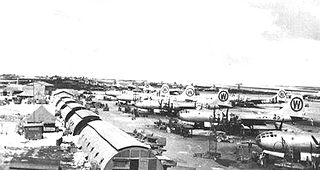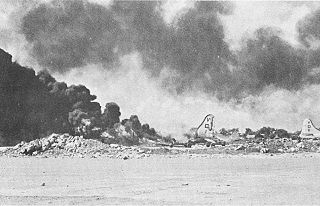
Operation Matterhorn was a military operation of the United States Army Air Forces in World War II for strategic bombing by Boeing B-29 Superfortress bombers based in India, Ceylon and China. Targets included industrial facilities in Japan, China and Southeast Asia.

The bombing of Kobe in World War II on March 16 and 17, 1945, was part of the strategic bombing campaign waged by the United States against military and civilian targets and population centers during the Japan home islands campaign in the closing stages of World War II. The city would be bombed again in later months.

The bombing of Osaka during World War II was part of the strategic bombing campaign waged by the United States against military and civilian targets and population centers in Japan. It first took place from the middle of the night on March 13, 1945, to the early morning of the next day. There were also bomb raids on June 1, 6, 7, 15, 26, July 10, 24, and August 14, the last day of the war. It is said that more than 10,000 civilians died in these bombings in Osaka, Japan.

During World War II, Allied forces conducted air raids on Japan from 1942 to 1945, causing extensive destruction to the country's cities and killing between 241,000 and 900,000 people. During the first years of the Pacific War these attacks were limited to the Doolittle Raid in April 1942 and small-scale raids on military positions in the Kuril Islands from mid-1943. Strategic bombing raids began in June 1944 and continued until the end of the war in August 1945. Allied naval and land-based tactical air units also attacked Japan during 1945.

The Japanese city of Kure, Hiroshima was attacked repeatedly by Allied aircraft during World War II. These raids targeted the major naval base located at the city, ships moored at this base or nearby, industrial facilities, and the city's urban area itself.

The XXI Bomber Command was a unit of the Twentieth Air Force in the Mariana Islands for strategic bombing during World War II.

The 505th Bombardment Group is an inactive United States Air Force unit. Its last assignment was with Thirteenth Air Force, stationed at Clark Field, Philippines. It was inactivated on 30 June 1946.

The 768th Bombardment Squadron is an inactive United States Air Force unit. It was last assigned to the 462d Strategic Aerospace Wing at Larson Air Force Base, Washington, where it was inactivated on 25 June 1966. The squadron was first activated in 1943, and became one of the earliest Boeing B-29 Superfortress units. It moved to the China Burma India Theater in April 1944 and participated in the first attack on the Japanese Home Islands since the 1942 Doolittle Raid on 15 June 1944. It earned three Distinguished Unit Citations. The squadron moved to Tinian with the rest of the 58th Bombardment Wing in April 1945 and continued its participation in the strategic bombing campaign against Japan until V-J Day. In November 1945, it returned to the United States, where it was inactivated in April 1946.

The 769th Bombardment Squadron is a former United States Army Air Forces unit. It was last assigned to the 462d Bombardment Group at MacDill Field, Florida, where it was inactivated on 31 March 1946. The squadron was first activated in 1943, and became one of the earliest Boeing B-29 Superfortress units. It moved to the China Burma India Theater in April 1944 and participated in the first attack on the Japanese Home Islands since the 1942 Doolittle Raid on 15 June 1944. It earned three Distinguished Unit Citations. The squadron moved to Tinian with the rest of the 58th Bombardment Wing in April 1945 and continued its participation in the strategic bombing campaign against Japan until V-J Day. In November 1945, it returned to the United States, where it was inactivated in April 1946.

The 770th Bombardment Squadron is a former United States Army Air Forces unit. It was last assigned to the 462d Bombardment Group at MacDill Field, Florida, where it was inactivated on 31 March 1946. The squadron was first activated in 1943, and became one of the earliest Boeing B-29 Superfortress units. It moved to the China Burma India Theater in April 1944 and participated in the first attack on the Japanese Home Islands since the 1942 Doolittle Raid in June 1944. It earned its three Distinguished Unit Citations. The squadron moved to Tinian with the rest of the 58th Bombardment Wing in April 1945 and continued its participation in the strategic bombing campaign against Japan until V-J Day. In November 1945, it returned to the United States, where it was inactivated.
The 771st Bombardment Squadron is a former United States Army Air Forces unit. The squadron was activated in 1943, and became one of the earliest Boeing B-29 Superfortress units. It moved to the China Burma India Theater in April 1944 and participated in the first attack on the Japanese Home Islands since the 1942 Doolittle Raid in June 1944. In August 1944, it earned a Distinguished Unit Citation. It was inactivated on 12 October 1944, when the Army Air Forces reorganized its very heavy bomber groups to consist of three, rather than four squadrons.

The Bombing of Yawata on the night of 15–16 June 1944 marked the beginning of the United States Army Air Forces (USAAF) strategic bombing campaign against the Japanese home islands during World War II and was the first such raid to employ strategic bombers. The raid was undertaken by 75 Boeing B-29 Superfortress heavy bombers staging from bases in China. Only 47 of these aircraft dropped bombs near the raid's primary target, the Imperial Iron and Steel Works at Yawata in northern Kyūshū, and little damage was caused. Five B-29s were lost in accidents during the operation and two were destroyed by Japanese aircraft.

The 782nd Tactical Air Support Training Squadron is an inactive United States Air Force unit. The squadron's most distinguished predecessor is the 792nd Bombardment Squadron, which was organized in 1943 as one of the first Boeing B-29 Superfortress units, The squadron participated in the strategic bombing campaign against Japan, earning three Distinguished Unit Citations. It returned to the United States following V-J Day and briefly became one of the first units in Strategic Air Command before inactivating at the end of March 1946.

The 793d Bombardment Squadron is a former United States Army Air Forces unit. The squadron was organized in 1943 as one of the first Boeing B-29 Superfortress units. After training in the United States, The squadron moved to India and participated in the strategic bombing campaign against Japan. When bases in the Mariana Islands became available, the squadron moved to Tinian, where it was able to strike targets in Japan without staging through forward bases. It earned three Distinguished Unit Citations during its combat tour. It returned to the United States following V-J Day and briefly became one of the first units in Strategic Air Command before inactivating at the end of March 1946.

The 484th Bombardment Squadron is an inactive United States Air Force unit. It was last assigned to the 505th Bombardment Group at Clark Field, Philippines, where it was inactivated on 10 June 1946.

The Bombing of Singapore (1944–1945) was a military campaign conducted by the Allied air forces during World War II. United States Army Air Forces (USAAF) long-range bomber units conducted 11 air raids on Japanese-occupied Singapore between November 1944 and March 1945. Most of these raids targeted the island's naval base and dockyard facilities, and minelaying missions were conducted in nearby waters. After the American bombers were redeployed, the British Royal Air Force assumed responsibility for minelaying operations near Singapore and these continued until 24 May 1945.

During World War II, a series of Japanese air attacks on the Mariana Islands took place between November 1944 and January 1945. These raids targeted United States Army Air Forces (USAAF) bases and sought to disrupt the bombing of Japan by Boeing B-29 Superfortress heavy bombers operating from the islands. The Japanese lost 37 aircraft during this operation, but destroyed 11 B-29s and damaged a further 43. Preparations were also made for commando raids on the bases in early and mid-1945 but these did not go ahead.

On the night of 9/10 March 1945, the United States Army Air Forces (USAAF) conducted a devastating firebombing raid on Tokyo, the Japanese capital city. This attack was code-named Operation Meetinghouse by the USAAF and is known as the Great Tokyo Air Raid in Japan. Bombs dropped from 279 Boeing B-29 Superfortress heavy bombers burned out much of eastern Tokyo. More than 90,000 and possibly over 100,000 Japanese people were killed, mostly civilians, and one million were left homeless, making it the most destructive single air attack in human history. The Japanese air and civil defenses proved largely inadequate; 14 American aircraft and 96 airmen were lost.

Operation Boomerang was a partially successful air raid by the United States Army Air Forces' (USAAF) XX Bomber Command against oil refining facilities in Japanese-occupied Dutch East Indies during World War II. The attack took place on the night of 10/11 August 1944 and involved attempts to bomb an oil refinery at Palembang and lay mines to interdict the Musi River.
United States Army Air Forces B-29 Superfortress heavy bombers made two air raids on railway facilities in Japanese-occupied Kuala Lumpur during February and March 1945. The first of these attacks took place on 18 February, and involved 48 or 49 B-29s based in West Bengal. The second raid was made on 10 March by either 24 or 26 aircraft. These attacks inflicted extensive damage on the Central Railroad Repair Shops. No American aircraft were lost in either operation.
















